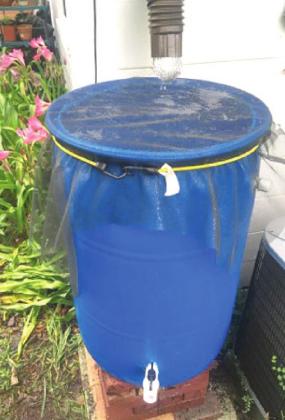It’s that time of year where daily afternoon showers bring a lot of rain. One way to take advantage of this rain is by installing a rain barrel. Rain barrels collect water that falls from your roof. This water can be stored and used for indoor plants, landscaping, and lawn.
Rain barrels benefit by reducing the need for irrigation from a well or municipal source, prevent erosion, provide water during droughts, and can improve local water quality by reducing stormwater runoff.
You can purchase a pre-assembled rain barrel, or create one yourself. Typically, a 55-gallon drum is used. Be sure that the barrel you select is food grade.
First, saw off the top and attach a screen mesh over the hole. You can attach the screen with a bungee cord.
Next, install a spigot six inches from the bottom of the barrel. You will also need an overflow hole and tube towards the top of the barrel. This is very important because with heavy showers the barrel will fill quickly, and you want to divert the overflow water away from your foundation.
Whether you purchase a completed rain barrel or do-it-yourself, carefully select where you will install the barrel. Select a gutter where sufficient rain flows, but not one that is likely to lead to quick overflows. If your house does not have a gutter system, you can place the barrel under a roof valley where water typically runs off.
Prepare the ground surface by raking away debris and making it level. You need to create a sturdy and level platform with pavers or bricks. Due to gravity, water will flow out of the barrel’s spigot more quickly if it is placed higher up. Cut the gutter above the rain barrel. You can add a leaf catch and a flexible gutter extender to better direct the water into the barrel.
It’s essential to regularly clean the barrel to control bacteria, algae, and mosquitos. You should clean it out once or twice a year with a 5% dilute bleach solution. Rinse it well, and dump the rinse water in a household drain. Keep mosquitos at bay by ensuring the mesh screen on top of the barrel is tight and there are no holes. You can also add a mosquito BTI dunk to the barrel if mosquitos become a problem.
If you have any questions about rain barrels, contact UF/IFAS Extension Osceola County at 321-697-3000.




